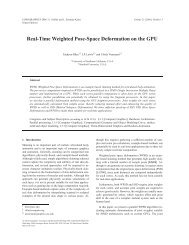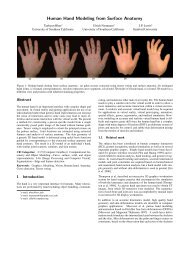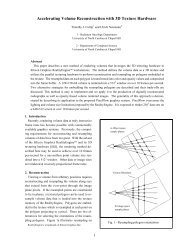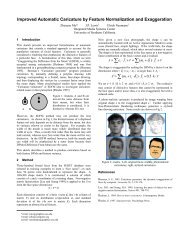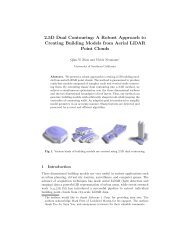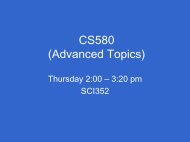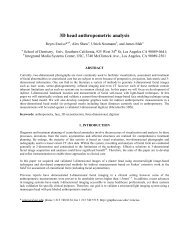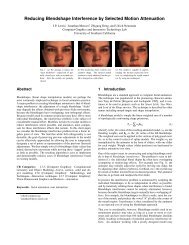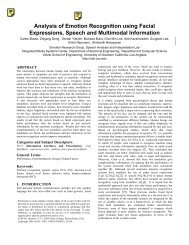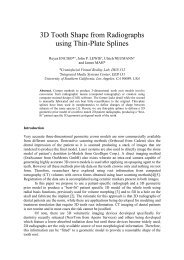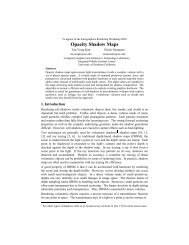The Gixel Array Descriptor (GAD) for Multi-Modal Image Matching
The Gixel Array Descriptor (GAD) for Multi-Modal Image Matching
The Gixel Array Descriptor (GAD) for Multi-Modal Image Matching
Create successful ePaper yourself
Turn your PDF publications into a flip-book with our unique Google optimized e-Paper software.
achieved by an additive scoring method. <strong>The</strong> score obtained<br />
with small line segments of similar orientation and distance<br />
to the <strong>Gixel</strong> is similar to the score obtained from a long connected<br />
line of the same orientation and distance. In multimodal<br />
data, due to different sensor characteristics, line features<br />
may appear with gaps or zig-zag segments. <strong>Gixel</strong>’s<br />
additive scoring method samples broken or solid lines with<br />
similar scores. This is essential <strong>for</strong> multi-modal matching.<br />
Figure 1 shows an example matching result of the <strong>Gixel</strong>based<br />
descriptor, between an ordinary image and a “pencil<br />
drawing” stylized image.<br />
Our main contributions include:<br />
• We observe that line features are the most important<br />
and reliable features in many multi-modal matching<br />
applications.<br />
• We propose the <strong>Gixel</strong> <strong>Array</strong> <strong>Descriptor</strong> (<strong>GAD</strong>) to<br />
extract line features, and thus per<strong>for</strong>m robustly <strong>for</strong><br />
matching multi-model images, especially on edgedominant<br />
images with little texture.<br />
• We demonstrate that the <strong>GAD</strong> can achieve good<br />
matching per<strong>for</strong>mance in various multi-modal applications,<br />
while maintaining a per<strong>for</strong>mance comparable to<br />
several state-of-the-art descriptors on single modality<br />
matching.<br />
2. Related Work<br />
<strong>The</strong> existing keypoint descriptors can be roughly classified<br />
into two categories: <strong>The</strong> ones based on intensity or<br />
gradient distribution, and the ones based on pixel comparison<br />
or ordering.<br />
<strong>The</strong> distribution-based descriptors are more traditional,<br />
which can be dated back to the works of Zabih and Woodfill<br />
[3], Johnson and Hebert [4] and Belongie et al. [5]. An<br />
important representative descriptor in this category is SIFT<br />
(Scale-Invariant Feature Trans<strong>for</strong>m) [6], which coded orientation<br />
and location in<strong>for</strong>mation of gradients in the descriptor<br />
region into a histogram, weighted by magnitude. Ke<br />
and Sukthankar [7] reduced the complexity of SIFT with<br />
PCA, leading to PCA-SIFT which is faster but also less distinctive<br />
than SIFT. Mikolajczyk and Schmid [1] proved the<br />
great per<strong>for</strong>mance of SIFT, and proposed a new descriptor<br />
based on SIFT by changing its location grid and reducing<br />
redundancy through PCA. <strong>The</strong> resulting GLOH is more distinctive<br />
than SIFT, but at the same time more expensive to<br />
compute. Bay et al. [2] proposed SURF (Speeded-Up Robust<br />
Features), using integral images to reduce the computation<br />
time, while still retaining the same gradient distribution<br />
histograms of SIFT. SURF [2] has proved to be one of the<br />
best descriptors in various circumstances.<br />
Recently, comparison-based descriptors are attracting attention.<br />
<strong>The</strong>se descriptors use relative comparison or ordering<br />
result of pixel intensities rather than the original inten-<br />
sities, resulting in much more efficient descriptor computation,<br />
while still maintaining per<strong>for</strong>mance competitive to<br />
distribution-based descriptors such as SIFT or SURF. Tang<br />
et al. [10] proposed a 2D histogram in the intensity ordering<br />
and spatial sub-division spaces, resulting in a descriptor<br />
called OSID, invariant to complex brightness change as<br />
long as it’s monotonically increasing. Calonder et al. [8]<br />
proposed BRIEF, using a binary string consisting the results<br />
of pair-wise pixel intensity comparison at pre-determined<br />
location, which is very fast in descriptor extraction and<br />
matching, but also very susceptible to rotation and scale<br />
changes. Rublee et al. [9] improved BRIEF into ORB (Oriented<br />
BRIEF), so that it’s rotation invariant and also resistant<br />
to noise. <strong>The</strong>re are several other descriptors within this<br />
category [11][12][13]. However, this type of descriptor relies<br />
heavily on extensive texture, thus they are not suitable<br />
<strong>for</strong> multi-modal matching. <strong>The</strong> proposed <strong>Gixel</strong>-based descriptor<br />
belongs to the distribution-based category.<br />
3. Introduction to <strong>Gixel</strong><br />
A <strong>Gixel</strong>, or “Gradient Pixel”, is a sample point <strong>for</strong> the<br />
gradient in<strong>for</strong>mation in a small local region on an image.<br />
A traditional Pixel would capture the pictorial in<strong>for</strong>mation<br />
of its neighborhood, and produce an intensity value or a 3D<br />
vector (R, G, B). Likewise, a <strong>Gixel</strong> would extract and summarize<br />
the gradient in<strong>for</strong>mation of its neighborhood. All<br />
line segments or pixelized gradients within the neighborhood<br />
of a <strong>Gixel</strong> are sampled (or scored) to produce a 2D<br />
vector of both x and y gradient data.<br />
3.1. Additive Edge Scoring<br />
For each line segment or pixelized gradient (a pixel gradient<br />
is considered as a line segment of length 1), a <strong>Gixel</strong><br />
creates a score, which encodes three elements of in<strong>for</strong>mation:<br />
orientation, length, and distance to the <strong>Gixel</strong>. <strong>The</strong><br />
longer a line segment is, the higher it is scored. Similarly,<br />
the nearer a line segment is to the <strong>Gixel</strong>, the higher it is scored.<br />
<strong>The</strong> score is then divided into x and y components<br />
according to the orientation of the line segment or gradient.<br />
In addition, sensor noise or inaccurate edge detection<br />
usually results in small gaps, zigzags, or other artifacts along<br />
the line, as shown in Fig.2(a, b). <strong>The</strong> design of the<br />
scoring function makes it additive, so that a sequence of<br />
short line segments achieves a similar score as a long connected<br />
line, as shown in Fig.2(c).<br />
<strong>The</strong> function f(x) = 1/(1+x): has the properties that<br />
f(0) = 1, f(+∞) = 0, and f(x) decreases as the input<br />
valuex increases.<br />
<strong>The</strong> scoring function is constructed from f(x). Given<br />
a line segment’s length l, and distance to the <strong>Gixel</strong> d, the<br />
score is defined as:<br />
Score(l,d) = f(d)−f(d+l) = 1<br />
1+d −<br />
1<br />
1+d+l (1)



